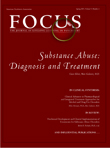New Medication Strategies for Comorbid Substance Use and Bipolar Affective Disorders
Abstract
Comorbidity of substance abuse disorders (SUD) with bipolar disorders (BPD) is a serious treatment problem. Childhood BPD can be further complicated by comorbidity with attention-deficit/hyperactivity disorder (ADHD) and later SUD during adolescence. The aim of this article is to review the literature on pharmacotherapies for these patients. Developing the ideal pharmacotherapy for BPD and SUD can be informed by the role of γ-aminobutyric acid (GABA) in the neurobiology of SUD. This ideal pharmacotherapy would have several key characteristics. These characteristics include treating the BPD, relieving withdrawal symptoms, and preventing relapse to SUD. The ideal medication should have low abuse liability, require infrequent dosing, be well tolerated, and have few side effects. A medication approaching this ideal is the GABA enhancer valproate. Adding atypical antipsychotic agents might not improve valproate's efficacy, but combining GABA medications with selective serotonin reuptake inhibitors holds promise for SUD with depression. Pemoline might be the best option for minimizing the risk of SUD complicating comorbid ADHD with BPD.
(Reprinted with permission from Biological Psychiatry 2004; 56:771–777)



